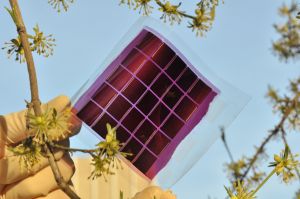KIT intensifies printable organic solar cell research. A group of researchers headed by Dr. Alexander Colsmann at the Light Technology Institute (LTI) will start work this month. The project is scheduled for a duration of four years and aims at enhancing the efficiency of organic solar cells to more than 10%. For this purpose, the researchers use tandem architectures combining solar cells of complementary absorption spectra. The Federal Ministry of Education and Research has granted funding of EUR 4.25 million.
The new generation of solar cells is light, flexible, semi-transparent, and allows for a low-cost production. Organic solar cells (plastic solar cells) can be applied to surfaces of nearly any shape by state-of-the-art printing and coating processes. Organic photovoltaics open up new perspectives in particular for the architectural design of buildings. The solar modules can be integrated in facades and even windows. In addition, they open up new OEM applications in the automotive or consumer sectors.
Organic solar cells are fabricated by low-cost printing and coating processes, such as gravure printing, screen printing, slot-die coating or spray coating in continuous roll-to-roll processes. Plastic carriers provide for the mechanical flexibility of the modules. At the same time, organic solar cells are characterized by an extremely low consumption of environmentally compatible resources, unprob-lematic disposal, and a very short energy payback time.
Still, organic solar cells exhibit moderate power conversion efficien-cies only. For them to be able to compete with established inorganic solar cells, extensive research is required. The early career scientists in the team of Dr. Alexander Colsmann, KIT, use so-called tandem architectures. Two solar cells with complementary absorption characteristics are stacked directly on top of each other to achieve better sunlight harvesting and more efficient energy conversion. The KIT scientists use novel materials, develop innovative device architectures, optimize their stability, and test the solar cells in a real-life environment. Moreover, they transfer man-ufacturing processes from the laboratory to an industry-compatible production environment in order promote future commercial use of their results. “The funding of EUR 4.25 million granted by the Federal Ministry of Education and Research (BMBF) reflects the quality of our work,” Colsmann says. He heads the Organic Photovoltaics Group at the Light Technology Institute of KIT.
In this project the KIT researchers are supported by the Fraunhofer Institute for Applied Polymer Research (IAP), Potsdam, represented by Dr. Hartmut Krüger, and the University of Queensland/Australia, represented by Professor Paul Burn, who supply new materials for organic solar cells. Merck KGaA is the industry advisor of the pro-ject.
Karlsruhe Institute of Technology (KIT) is one of Europe’s leading energy research establishments. The KIT Energy Center pools fundamental research with applied research into all relevant energy sources for industry, households, services, and mobility. Holistic assessment of the energy cycle also covers conversion processes and energy efficiency. The KIT Energy Center links excellent competences in engineering and science with know-how in economics, the humanities, and social science as well as law. The activities of the KIT Energy Center are organized in seven topics: Energy conversion, renewable energies, energy storage and distribution, efficient energy use, fusion technology, nuclear power and safety, and energy systems analysis.
Research, education, and innovation at KIT foster the energy turnaround and reorganization of the energy system in Germany. Clear priorities lie in the areas of energy efficiency and re-newable energies, energy storage technologies and grids, elec-tromobility, and enhanced international cooperation in research.
In close partnership with society, KIT develops solutions for urgent challenges – from climate change, energy transition and sustainable use of natural resources to artificial intelligence, sovereignty and an aging population. As The University in the Helmholtz Association, KIT unites scientific excellence from insight to application-driven research under one roof – and is thus in a unique position to drive this transformation. As a University of Excellence, KIT offers its more than 10,000 employees and 22,800 students outstanding opportunities to shape a sustainable and resilient future. KIT – Science for Impact.

